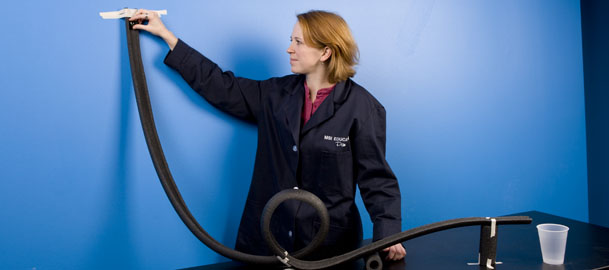Class Activity: Build a Roller Coaster
(Activity courtesy of the Museum of Science and Industry, Chicago. Click HERE for PDF from Discover Engineering that contains updated material from the American Society for Civil Engineering’s 2016 IMAX movie, Dream Big,)
Level: Grades 3-6
Time required: Approximately one class period
In this activity, late-elementary school students work in small groups to build a roller coaster with at least one loop and one jump, demonstrating how potential energy transforms into kinetic energy. Students observe the relationship of height to potential energy and the resulting kinetic energy.
Background: How Roller Coasters Work from the website How Stuff Works. http://science.howstuffworks.com/roller-coaster.htm
Marbles or small balls
About 6 feet of flexible tubing, such as 3/4-inch foam pipe insulation
Masking tape
Plastic cup
Scissors
Various supports, such as boxes, paper towel tubes or books
Key terms:
Kinetic Energy — Energy from motion
Potential Energy — Stored energy that transforms into kinetic energy
STEPS
1. Cut the tubing in half
This doubles the amount of “track” for the roller coaster.
2. Assemble the track
Your car — the marble — needs enough “stored” energy at the beginning of the roller coaster to make it through the entire course. How should the tubing for the beginning of the roller coaster be positioned? Use tape and various supports to create the starting point. Use the tubing, tape, and supports to build the rest of your roller coaster. Try to include at least one loop, hill, and jump.
3. Place the cup
Put the plastic cup at the end of the course. The challenge is to get the marble to land in the cup.
4. Test your coaster
Place your marble at the beginning of your roller coaster and let it go. Did it work? If not, figure out what went wrong, and make adjustments to your course, as needed.
Once you get your roller coaster to work, try this next: Start the coaster at a higher point and see what happens. Then, try a different design,adding more loops, hills or curves to your course.
5. What are the engineering concepts at work?
A roller coaster demonstrates kinetic energy and potential energy. A marble at the top of the track has potential energy. When the marble rolls down the track, the potential energy is transformed into kinetic energy. Real roller coasters use a motor to pull cars up a hill at the beginning of the ride. Cars that are stopped at the top of the hill have potential energy. As the car rolls down the hill, the potential energy becomes kinetic energy.
Filed under: Class Activities, Grades K-5
Tags: Class Activities, forces and motion, friction, Grades 3-6, Grades K-5, kinetic energy, Mechanical engineering, roller coaster









